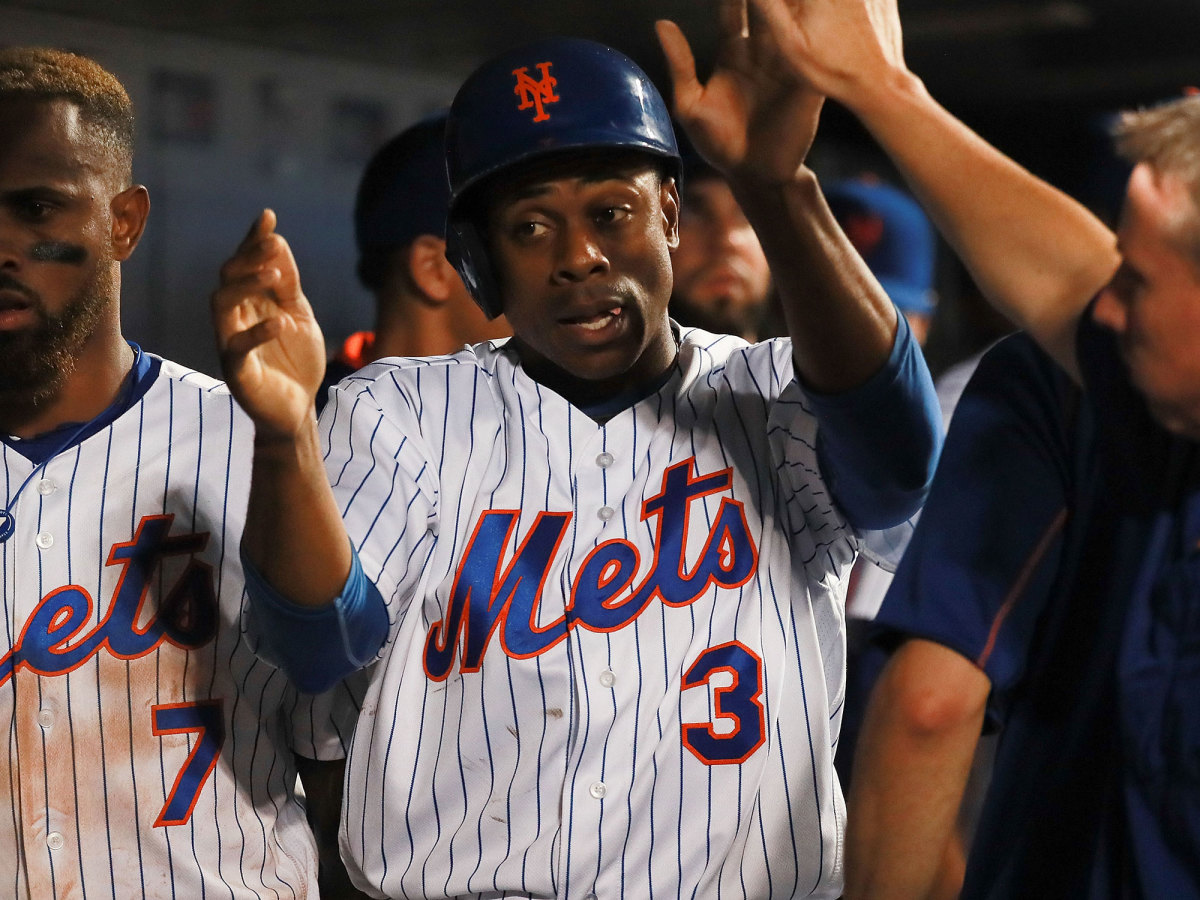Team Entropy update: AL, NL wild cards are best hope for massive ties

With 12 days to go in the regular season, the various division and wild-card races in both leagues have simplified at least somewhat. That’s not great if you’re rooting for Team Entropy, though several complicated scenarios are still in play.
For a quick refresher on (or introduction to) what Team Entropy is and what it's all about, check out my piece from last week laying out all the massive tie scenarios across the various divisions and in both wild cards. For this, you'll want to keep in mind the Baseball Prospectus Playoff Odds and MLB's official tiebreaking scenarios. Now, let's get to the most recent developments.
The Divisions
Since I reintroduced the concept a week ago, the Cubs have clinched the National League Central, and none of the other division races have gotten any closer save for the NL East, where the Nationals' margin over the Mets has been reduced from nine games to eight. Indeed, this year is something of a dud for division races, but here’s what’s left.
• In the NL West, the Dodgers are 85–66 with a five-game lead over the Giants. Los Angeles' odds of winning the division are now at 97.4% and its magic number is at seven. The Dodgers' 2-1 win on Monday night took San Francisco's fate out of its own hands; even with Tuesday’s win, the Giants now have just four games left against L.A., so they need help from other teams if they're going to retake the division lead. If there's one thing going in San Francisco's favor here, it's that it leads the season series, 8–7; whoever's ahead after the full complement of 19 games would host a Game 163 tiebreaker.
Three Strikes: Jay Bruce’s struggles continue; is there a wild-card darkhorse?
• In the AL East, the Red Sox' lead over the Blue Jays and Orioles is four and five games, respectively, and their margin over the Yankees has climbed to 8 1/2 thanks to a decisive four-game sweep at Fenway Park last weekend. With it, Boston's odds of winning the division have soared from 70.7% to 94.6%, and its magic number to clinch is now eight, reduced by four games over the past two nights via wins over Baltimore in the first half of a four-game set at Camden Yards. The O's chances at winning the division are down to a measly 1.2%; Toronto's are at 4.3%; and New York's have gone down to “Yogi Berra called from the afterlife to say, ‘It ain't over, but don’t call us, we’ll call you.’”
With that out of the way, we turn to the wild-card races, both of which still have some fight left.

NL Wild Card
While the Marlins (76–75, 1.2%) are technically alive, the real news is that the Mets, Giants and Cardinals come into Wednesday tied for the two spots at 80–71. In the last head-to-head series among these three teams—which ran from last Thursday through Sunday—the Cardinals and Giants split four games in San Francisco. With that, we can now figure out the pecking order if the three teams end the regular season tied for the two spots, which would be based on combined head-to-head records. The Mets are 4–3 against the Giants and 3–3 against the Cardinals, and the Giants are 3–4 against the Cardinals, so New York and St. Louis are both 7–6 among this pool, and San Francisco is 6–7. In other words: We're not done yet.
Since the Mets and Cardinals have an even split against each other, the next tiebreaker between the two teams—should one be required—is intradivision winning percentage. The Mets are just 33–32 (.508) against the NL East, though all 11 of their remaining games are within the division: one against the Braves at home, seven against the Phillies (four from this Thursday to Sunday at Citi Field and then three to finish the season at Citizens Bank Park) and three against the Marlins in Miami. The Cardinals are 36–30 (.545) against the NL Central, albeit with three remaining against the Cubs in Chicago and then seven at home: four versus the Reds, three versus the Pirates.
Hurting Harper among Nationals' concerns, but Washington still a threat to Cubs
Thus, if St. Louis' advantage is preserved, it would host Game 163 in the event the two teams are tied for one spot. If all three teams are tied, the Cardinals would get first choice as to whether they want to be Club A, B or C in the following scenario: Club A hosts Club B on Oct. 3 (yielding one wild card team), with Club C hosting the loser on Oct. 4 (yielding the second wild card team). The Mets would choose second, the Giants last
If you're wondering what the BP odds say, they've got New York with a 71.6% chance of making it in via the wild card (thanks in large part to its cupcake schedule), St. Louis at 64.3% and San Francisco at 60.2% (plus 2.6% to retake the NL West). Stay tuned.
AL Wild Card
With the Royals (77–74) five games out of the second spot and down to 0.2%, it's probably safe to write the reigning world champions out of this. Even so, that still leaves six teams in this scrum, separated by 5 1/2 games form top to bottom, with the Blue Jays (83–58, 77.4% odds for one spot) and Orioles (82–69, 50.7%) currently in the drivers' seats. The Tigers (80–70, 30.9%) are 1 1/2 games behind the Orioles; the Astros (80–71, 23.4%) are two games back; and the Mariners (79–72, 8.1%) and Yankees (78–72, 3.3%) are three and 3 1/2 games back, respectively.
Keeping things interesting is the combatants’ relative strength of schedule, which via Baseball Prospectus' newest gizmo shows that the Yankees (.563) now have the third-toughest remaining slate of the 30 teams in a calculation that is "based primarily on roster composition but also 3rd-order win% [and] adjusted for home/away," with .500 representing average. The Blue Jays are fourth (.547), the Orioles are fifth (.538) and the Red Sox are sixth (.529, with nine games against Baltimore, New York and Toronto keeping the division door ajar). Further down, the Tigers (.479) have five against the Braves and Twins to offset seven against the Royals and Indians. Out west, the Mariners (.466) have the seventh-easiest schedule and the Astros (.449) the second-easiest, behind only the Mets; they have just the A's, Angels and Mariners left.
MLB playoff picture: Wild card, ALDS and NLDS matchups
With a tie atop the AL East—thus spilling over into the determination of a wild card or even two—an increasingly remote possibility, unpacking how this would play out becomes a bit easier. Again, the basis of the pecking order will be determined by head-to-head winning percentages among the pool of teams that are tied, with intradivision and then intraleague winning percentages the next tiebreakers. With so many teams still involved, and so many games still to play among them (particularly within the East and West divisions), I'm not going to dig through all of the permutations yet, but here’s the grid up to this point if you want to twist yourself into a pretzel at home.
team | tor | bal | det | hou | sea | nyy |
|---|---|---|---|---|---|---|
TOR | — | 9–7 | 4–3 | 5–2 | 3–2 | 9–6 |
BAL | 7–9 | — | 5–2 | 1–6 | 1–6 | 8–8 |
DET | 3–4 | 2–5 | — | 4–2 | 4–3 | 3–3 |
HOU | 2–5 | 6–1 | 2–4 | — | 10–6 | 2–4 |
SEA | 2–3 | 6–1 | 3–4 | 6–10 | — | 3–3 |
NYY | 6–9 | 8–8 | 3–3 | 4–2 | 3–3 | — |
Once that pecking order is determined, teams draft their spots (A, B, C or D) to fit into the following scenarios:
• If four teams are tied for two slots, the scenario would start with Club B @ Club A and Club D @ Club C on Oct. 3, with the winners declared the wild-card teams and the wild-card game played in the A/B winner's park on Oct. 4.
• If four teams are tied for one spot, the A/B and C/D winners meet in the A/B park, with that winner the wild-card team.
• If three teams are tied for two spots, that would again be Club B @ Club A on Oct. 3 (yielding one wild-card team), with the winner hosting Club C on Oct. 4 (yielding the second wild-card team) and then the wild-card game itself pushed to Oct. 5.
• If three teams are tied for one spot, then the B @ A winner hosts C, with the winner a wild-card team
If five or even six teams are involved in a tie—honestly, I'm not sure that's even possible—then the alphabet soup would include E and F designations, but that's a bridge that MLB's schedule makers haven't jumped off, or at least published. We should be so lucky to find out!
